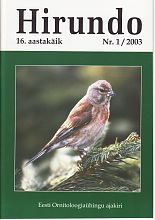Hirundo 1/2003
Lõhmus, A.
Is it possible to determine the occupying species and nest age from the dimensions of raptor nests?
Summary: Determining the occupying species and age of the nests of forest-dwelling raptors is important both in the conservation of threatened raptor species and raptor monitoring. This paper explores whether the relevant determination criteria could be simply derived from nest measurements, which can be easily taken by anyone able to climb the nests. The data were collected between 1991 and 2001 in a 900-km2 study area near Tartu, east-central Estonia. Three basic measurements (average diameter of nest and nest platform as well as nest depth; Fig. 1) were taken from more than 400 nests, representing six raptor species (Accipiter gentilis, A. nisus, Aquila clanga, A. pomarina, Buteo buteo, and Pernis apivorus). Although the average measurements differed significantly between the species (see Table 1 for the data of all nests and first-year nests), the ranges overlapped extensively. A discriminant analysis model failed to distinguish reliably between the species (Table 2), and I used an empirical approach to define the combinations of measurements, for which species determination was likely to be correct. In B. buteo, all three measurements increased with nest age (Fig. 2A), while in A. pomarina only nest depth increased (Fig. 2B). For these two species, linear regression models had a sufficient precision in estimating the nest age with an accuracy of ±1 yr up to 5 yr age (older nests were not further separated). In P. apivorus, nest dimensions did not change significantly with age. In general, nest dimensions were not a reliable criterion for conservation and monitoring purposes. Moreover, all the five larger species under consideration may switch to breed in a nest built by another species (at least two species nested in 15% of nests used for more than 2 yr; Table 3). Therefore, during forestry operations, large raptor nests and their immediate surroundings should be protected whenever possible.
Tuule, E., Tuule, A. & Elts, J.
Numbers and population dynamics of the Curlew in the surroundings of Saue, 1963-2002
Summary: Breeding Curlews (Numenius arquata) were counted in an approximately 100-km2 area in the surroundings of Saue (near Tallinn), 1963-2002. The landscape is mosaic and the share of open agricultural habitats has increased during the study years. The densities were estimated according to line transect counts on 50-m wide transects. The average annual density for the total area was 1.5 pairs/km2. The highest density was on meadows (3.7 p/km2), slightly less on pastures (2.4) and significantly smaller on arable fields (1.2) and woody and bushy meadows (0.7). The densities fluctuated most on pastures and were most stable on meadows. The total numbers of the species have been increased in the Saue area; among biotopes, the increases are reliable on arable fields and pastures.
Ellermaa, M.
The numbers of breeding bird populations in Pärnu county, 2000-2002
Summary: So far, the population estimates of Estonian breeding birds have been usually not based on standardized census methods and, hence, reliable data about abundancies of most species in larger regions are very scarce. We used the finnish line transect method to find out the sizes of breeding populations of about a hundred bird species in Pärnu county, SW Estonia (4800 km2). The results of the counts carried out 2000-2002 are compared with earlier estimates of breeding bird numbers in Pärnumaa.
Ellermaa, M.
Finnish line transect method
Summary: This paper is a methodological review of a powerful bird monitoring tool – the finnish line transect method (as described by Järvinen & Väisänen 1975) – and the possibilities of using it in Estonia. Correction coefficients for several Estonian breeding bird species, mostly derived from original material of the autor, are given in the Table 2. The English-speaking readers should consult the reference list for the details of the method.
Notes
Elts, J.
Variations in the results of Thrush Nightingale and Sedge Warbler counts
Aua, J.
Low breeding success in the Little Ringed Plover
EOS chronicle and news

